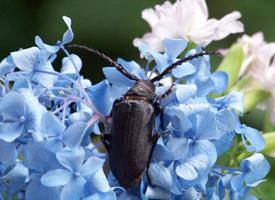
Popis zvířete
The House Longhorn Beetle, scientifically known as Hylotrupes bajulus, is a species of wood-boring beetle that is notorious for the damage it can cause to wooden structures. This beetle is part of the Cerambycidae family, which is known for its long antennae, hence the name "longhorn." The House Longhorn Beetle is primarily found in temperate regions and has a particular prevalence in parts of Europe, though it has also been identified in other regions due to global trade and movement.Adult House Longhorn Beetles are characterized by their elongated bodies, which can measure up to 25 millimeters in length. They exhibit a black or dark brown coloration with grayish or whitish spots on their wing cases (elytra), creating a distinctive pattern that aids in their identification. The beetles' long antennae, which can be as long as or longer than their bodies, are a defining feature of the species.
The lifecycle of the House Longhorn Beetle begins with the female laying her eggs in cracks and crevices of softwood, particularly favoring pine and spruce. The larvae, which are the primary cause of damage to timber, can spend anywhere from 3 to 11 years within the wood, depending on environmental conditions such as temperature and humidity. These larvae are creamy white in color and can grow up to 30 millimeters in length. They carve extensive galleries within the wood as they feed, significantly weakening the structural integrity of infested timbers. The feeding activity of the larvae produces a distinctive "tunnelling" sound, which is often the first indication of an infestation.
Once the larvae have completed their development, they pupate within the wood, emerging as adults to start the cycle anew. The emergence holes, which are oval-shaped and approximately 6 to 10 millimeters in diameter, are another visible sign of an infestation.
The presence of House Longhorn Beetles in structural timbers poses a significant risk to buildings, particularly in regions where the beetle is prevalent. Infestations can lead to the weakening of load-bearing structures, necessitating costly repairs and, in severe cases, replacement of the affected timbers. As a result, measures such as the use of treated wood, regular inspections, and the application of insecticides are commonly recommended to prevent or control infestations.
In summary, the House Longhorn Beetle (Hylotrupes bajulus) is a wood-boring insect that poses a significant threat to wooden structures due to the extensive damage caused by its larvae. With a lifecycle that can span several years within infested timber, early detection and control are critical in managing the risks associated with this pest.
Podobná zvířata
Nové fotografie zvířat
Top 10 zvířat
- Dolphin gull (Leucophaeus scoresbii)
- Diana monkey (Cercopithecus diana)
- Moustached guenon (Cercopithecus cephus)
- Galápagos tortoise (Geochelone nigra complex)
- Australian box jelly (Chironex fleckeri)
- Giant african land snail (Lissachatina fulica)
- Russian tortoise (Testudo horsfieldii)
- Common house mosquito (Culex pipiens)
- Greek tortoise (Testudo graeca)
- Japanese macaque (Macaca fuscata)


